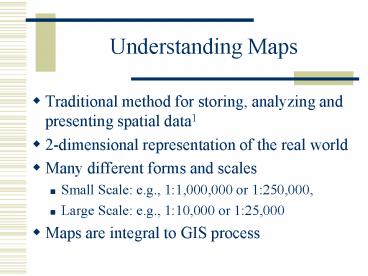Understanding Maps - PowerPoint PPT Presentation
1 / 35
Title: Understanding Maps
1
Understanding Maps
- Traditional method for storing, analyzing and
presenting spatial data1 - 2-dimensional representation of the real world
- Many different forms and scales
- Small Scale e.g., 11,000,000 or 1250,000,
- Large Scale e.g., 110,000 or 125,000
- Maps are integral to GIS process
2
Spatial Entities
- Map symbols representing real world features
- Points, lines and areas (polygons)
- Used by cartographers to depict, on paper,
3-dimensional features in 2-dimensions - Type of spatial representation depends on scale
used
3
Spatial Entities
4
Map Generalization
- All spatial data are simplifications of real
world features - Level of generalization is determined by map
scale OR - Dictated by limitations of data production OR
- Introduced by humans purposely to highlight
particular features
5
Scale Related Generalization
6
Mapping Involves
- Determining geographic locations of
earth features (impacts datum, scale, etc.) - Considering method for referencing locations
e.g., coordinate system - Transforming locations to a position on a
flat map through use of projection - Graphically symbolizing these features
7
Earth Size Shape Generalization
- Earths surface AREA is equal to that of a sphere
having a radius of 6,370 km - r 637,000,000 cm r 3,960 miles
- (generalized radius commonly used in map
creation) - Not really a sphere - generalized for mapping
- radius at Equator 6,378 km
- radius between Poles 6,356 km
8
Earth Size Shape Generalization
- Datum
- Reliable starting point from which accurate
measurements of the earths size can be made
(e.g., NAD27, NAD83) - Ellipsoid
- Hypothetical, nonspherical shape of earth that
resembles a flattening of the earth at the poles
due to rotation. Basis for datums. - Example
- Most 124,000 topographic maps from the US
Geological Society use polyconic projection, the
Clarke 1866 ellipsoid, NAD27 datum. NAD83
datum uses GRS80 ellipsoid.
9
World Datum Examples
10
Coordinate Systems Spatial Referencing
- Spherical Coordinate Systems
- Geographical coordinate system (Longitude
Latitude) - Rectangular Coordinate Systems
- UTM (Universal Transverse Mercator)
- UPS
- State Plane
- Non coordinate systems
11
Geographical Coordinate System
- Common globe referencing system
- based on perfect sphere not true earth shaped
ellipse - Lines of Latitude (a.k.a. parallels)
- Lines of Longitude (a.k.a. meridians)
12
Latitude and Longitude
North Pole
900 longitude
Lines of Latitude (East/West - parallels)
Lines of Longitude (North/South - meridians)
South Pole
Central Parallel
13
Reading Latitude Longitude
- reference system uses degrees minutes
- 550 45 N 360 0 E -- reads as
- 55 degrees 45 minutes north 360 degrees 0 minutes
east - first set of numbers (550 45 N) latitude
- N tells us this locational reference is north of
the equator - second set (360 0 E) longitude
- E indicates the remaining part of this locational
reference is east of the prime meridian - N and E tells us which quarter of the globe
14
Example USGS Topographic Map
- http//plymouth.ces.state.nc.us/staff/ameijer/for5
54/usgs.html - http//plymouth.ces.state.nc.us/staff/ameijer/for5
54/graphics/map-information-2.jpg
15
Rectangular Coordinate Systems
- Also referred to as Planar or Cartesian
Coordinate Systems (X,Y) - used for locating positions on a flat map of the
earths curved surfaces - principal axes
- X horizontal (easting)
- Y vertical (northing)
16
Grid Coordinate System
17
Universal Transverse MercatorSystem (UTM)
- Most widely used grid system in GIS
- Derived from Transverse Mercator projection
- Divides earth from latitudes 840 N 800 S into
60 numbered vertical zones 60 of longitude wide - Each UTM zone has its own central meridian which
covers 30 west 30 east of CM - Most USGS topographic maps use
- Areas outside of UTM grid (Polar areas) use the
UPS grid system - Measurement metric system
18
UTM Grid
19
UTM Grid
Source Clarke, Keith. (2001). Getting Started
with Geographic Information Systems. p. 57.
20
UTM Cell
Source Clarke, Keith. (2001). Getting Started
with Geographic Information Systems. p. 58.
21
U.S. UTM Zones
Source Clarke, Keith. (2001). Getting Started
with Geographic Information Systems. p. 54.
22
State Plane Coordinate System
- SPCS is a grid system developed by USGS in 1938
- Widely used in public works land surveys
- Divides US, Puerto Rico US Virgin Islands into
over 120 zones - Each zone has an assigned number which defines
its projection parameters
23
State Plane Coordinate System
- Three projections used for SPCS determined by
geometric direction of state - Lambert Conformal Conic for states longer in E/W
direction - Transverse Mercator for states longer in the N/S
direction - Oblique Mercator for panhandle of Alaska
24
SPCS U.S. Map
Source Demers, Michael. (2000). Fundamentals of
Geographic Information Systems. p. 65.
25
SPCS New Mexico
Source Demers, Michael. (2000). Fundamentals of
Geographic Information Systems. p. 65.
26
Projections
- Transfer spherical Earth into 2-dimensions
- The method where the world is laid flat
- Approximates true shape introduces errors
- distance preserved gt direction distorted
- shape preserved gt area calculations inaccurate
- Wide range of map projections in use
- Universal Transverse Mercator (UTM), Lambert
Conformal Conic, etc.
27
Map Projection Process
28
(No Transcript)
29
Azimuthal Projection
30
Cylindrical Projection
31
Conical Projection
32
Projection type features
- Conformal preserves shape
- Equivalent or equal area preserves area
- Combination preserves neither
33
Source Clarke, Keith. (2001). Getting Started
with Geographic Information Systems. p. 49.
34
- add comments/links recommended from list serve
35
(No Transcript)































